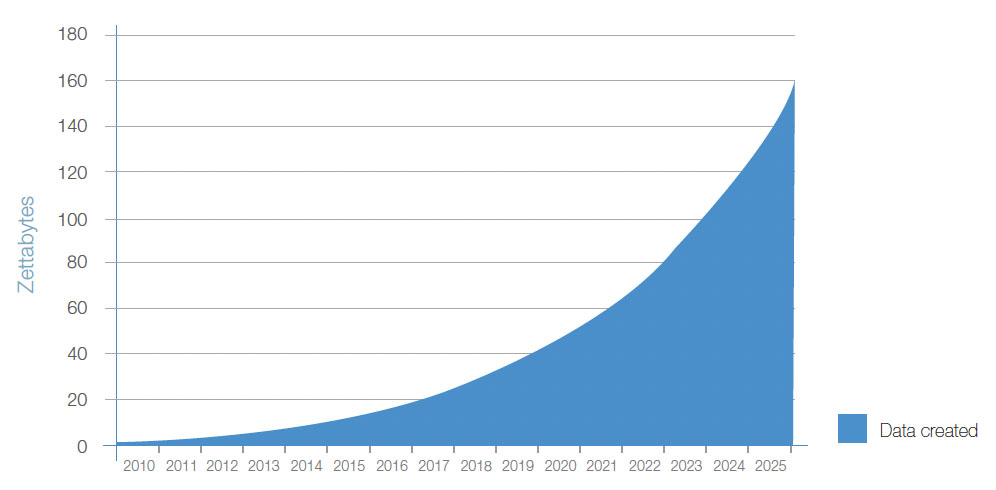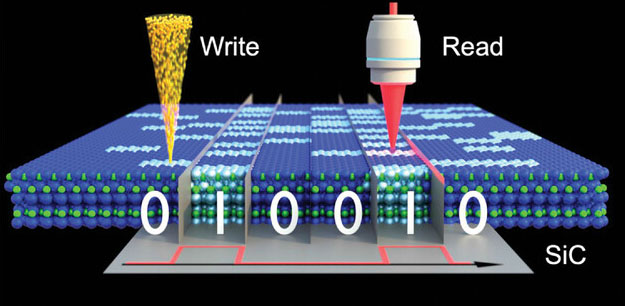| Apr 03, 2024 | |
Silicon carbide data storage technology could preserve information for millions of years |
|
| (Nanowerk Spotlight) The relentless growth of digital data, fueled by the rapid expansion of the internet, social media, and cloud technologies, has created an urgent need for innovative data storage solutions. In 2012, the amount of digital data worldwide surpassed one zettabyte (ZB or 1021 bytes), marking the beginning of the Zettabyte Era. | |
| Global data generation is expected to continue its exponential growth, with projections suggesting that it will exceed 100 ZB (that is 100 trillion gigabytes) per year by 2025. To keep pace with this staggering increase, the International Data Corporation (IDC) forecasts that over 22 ZB of storage capacity must be shipped across all media types between 2018 and 2025 (Data Age 2025 whitepaper, PDF). | |
 |
|
| Annual Size of the Global Datasphere. (Image: IDC) | |
| Current approaches, such as magnetic media, optical disks, and solid-state drives, are struggling to meet the demands of this rapid expansion in data generation. Beyond the challenge of increasing storage density, there is also a pressing need for long-term data archiving solutions that can preserve information for far longer than traditional storage methods allow. | |
| Over the past few decades, researchers have explored various avenues to address these challenges. Magnetic memory has been a primary choice for data archiving due to its large storage capacity, but the need to reduce magnetic particle size to increase storage density has led to issues with thermal fluctuations and diffusion processes, limiting the storage lifetime. Optical discs, while offering seemingly unlimited storage times, are constrained by the diffraction limit, which restricts the smallest recording bit to half the wavelength of light used, thereby limiting the maximum storage capacity. | |
| Other innovative approaches, such as DNA digital data storage and atomic-scale memories, have shown promise in terms of storage density but are currently impractical due to extremely slow writing and reading times. Color centers in solid-state materials, such as nitrogen-vacancy centers in diamond, have also been explored for data storage but have thus far only demonstrated limited retention times on the order of weeks. | |
| Now, a team of researchers from Germany, Japan, and the United States has proposed a novel concept for long-term, high-density data storage using silicon carbide (SiC), a radiation-resistant semiconductor material. Their approach, detailed in a paper published in Advanced Functional Materials ("Ultralong-Term High-Density Data Storage with Atomic Defects in SiC"), leverages the unique properties of atomic-scale defects in SiC, known as silicon vacancies (VSi), to store and retrieve digital information. | |
| The researchers create these VSi defects using focused ion beams, which allow for high spatial resolution, fast writing speeds, and low energy consumption per stored bit. The presence or absence of these defects represents binary data, which can be read out using the photoluminescence (PL) or cathodoluminescence (CL) emitted by the VSi defects when excited with laser light or electron beams, respectively. | |
 |
|
| A concept of long-term optical data storage in SiC. a) The information is written in optically active atomic defects by a focused ion beam and read using the defect PL or CL. The excitation wavelength is 785 nm. (Image: Advanced Functional Materials, CC BY 4.0) | |
| To demonstrate the potential of their approach, the researchers encoded a text message in a SiC sample using a proton microbeam. By varying the number of protons implanted at each spot (4 × 106, 8 × 106, or 1.2 × 107), they achieved a two-bit grayscale encoding scheme, where the absence of implantation corresponded to 00, and increasing implantation levels represented 01, 10, and 11, respectively. The recorded message was then successfully retrieved using a scanning confocal microscope to measure the PL intensity at each location. | |
| The team also explored the use of multi-layer encoding to increase storage capacity. By stacking multiple SiC wafers with recorded data and using the confocal microscope to selectively excite and read out VSi defects at different depths, they were able to store and retrieve data from multiple layers without cross-talk between them. This 4D encoding scheme, combining three spatial dimensions and a fourth intensity dimension, enabled a storage density of 75 gigabits per square inch for a ten-layer stack. | |
| To overcome the diffraction limit imposed by optical readout methods, the researchers turned to CL as an alternative. By exciting the VSi defects with a focused electron beam, they achieved a spatial resolution of approximately 360 nanometers, significantly better than what is possible with optical methods. Simulations suggest that by optimizing the SiC layer thickness and electron beam energy, the spatial resolution could be further improved to around 50 nanometers, potentially enabling storage densities of up to 300 gigabits per square inch, rivaling the record areal density of magnetic tapes. | |
| The energy required to write a single bit using this method is estimated to be around 10-50 femtojoules, which is lower than the energy consumption of magnetic disk drives (1 picojoule per bit) and solid-state drives (100 femtojoules per bit). The writing speed, limited by the required ion fluence and beam current, is projected to be around 10 megabits per second, faster than other optical data storage media. However, the reading speed, limited by the emission rate of the VSi defects, is estimated to be in the range of 100 kilobits per second for the 4D optical data storage and could be as low as 1 kilobit per second if single bits are stored in individual defects. | |
| Perhaps the most remarkable aspect of this new data storage approach is the potential longevity of the stored information. The researchers conducted a series of annealing experiments to investigate the temperature-dependent deactivation of the VSi defects. By heating the samples to temperatures ranging from 400 °C to 900 °C for varying durations and measuring the PL intensity decay, they were able to extract the activation energy for the deactivation process. | |
| By extrapolating the measured photoluminescence decay times to room temperature, they estimate that data stored using this method could be preserved for over 10 million years under ambient conditions, and around 9,000 years at 100 °C. This extraordinary storage lifetime far surpasses that of any currently available data storage technology. | |
| While this proof-of-concept study demonstrates the immense potential of SiC-based data storage, further research and development will be necessary to optimize and scale up this technology for practical applications. This includes investigating the creation of single VSi defects for ultra-high-density storage, improving the reading speed and energy efficiency, and developing high-speed ion beam blanking systems for faster writing. Additionally, the development of commercially viable fabrication processes and the integration of this technology with existing data storage infrastructure will be critical for its widespread adoption. | |
| As digital data continues to accumulate at an astonishing pace, the need for reliable, high-density, and long-term data storage solutions becomes increasingly critical. The silicon carbide-based approach developed by these researchers offers a promising path forward, potentially enabling the preservation of our digital heritage for countless generations to come. While there are still challenges to overcome, the groundbreaking work presented in this study represents a significant milestone in the quest for ultra-long, high-density data archiving. As we continue to grapple with the challenges posed by the explosive growth of digital information, innovations like this one will be crucial in ensuring that our most valuable data can be securely stored and accessed for centuries, if not millennia, to come. | |
 By
Michael
Berger
– Michael is author of three books by the Royal Society of Chemistry:
Nano-Society: Pushing the Boundaries of Technology,
Nanotechnology: The Future is Tiny, and
Nanoengineering: The Skills and Tools Making Technology Invisible
Copyright ©
Nanowerk LLC
By
Michael
Berger
– Michael is author of three books by the Royal Society of Chemistry:
Nano-Society: Pushing the Boundaries of Technology,
Nanotechnology: The Future is Tiny, and
Nanoengineering: The Skills and Tools Making Technology Invisible
Copyright ©
Nanowerk LLC
|
|
|
Become a Spotlight guest author! Join our large and growing group of guest contributors. Have you just published a scientific paper or have other exciting developments to share with the nanotechnology community? Here is how to publish on nanowerk.com. |
|
